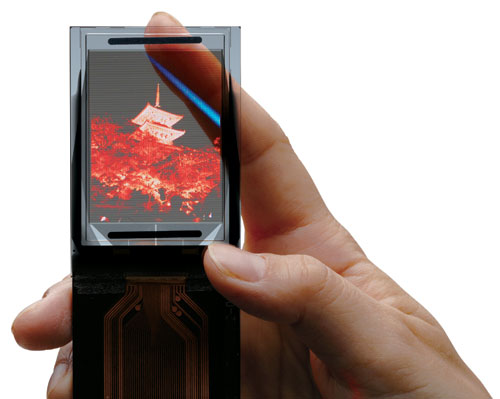TDK Organic See-Through Display
 TDK has pulled the wraps off their impressive HD transparent display tech. with mass production already underway: http://bit.ly/kRsXVo
TDK has pulled the wraps off their impressive HD transparent display tech. with mass production already underway: http://bit.ly/kRsXVo
Just Wow… required read for any who dare consider that Japan has somehow lost it’s edge! [Eds]
TDK Corporation has started mass production of a newly developed see-through passive matrix type QVGA organic EL display (product name: UEL476) from this Spring, a world’s first*
Organic EL displays are formed through thin-film techniques, using organic material that emits light in response to an electric current. High brightness, wide viewing angle and other favorable characteristics make this display type very easy on the eye, and since it also achieves fast response, Organic EL displays have been adopted for wider use in flat panel displays. All organic EL displays from TDK employ the passive matrix principle. The newly developed see-through type is mainly intended for use as the main display panel in mobile phones and other mobile devices.

The see-through type organic EL display for mobile applications has a field angle of 2.4 inches, transmittance of 40 percent, and brightness of 150 cd/m2. Compact mobile electronic devices such as mobile phones these days require a display that is appealing also from a design point of view. The newly developed product is a see-through type, but is constructed so that the display contents cannot easily be seen from behind, to protect the user’s privacy.
Glossary
— Passive matrix drive principle: One of the methods used to drive organic electroluminescent elements. A grid of vertical and horizontal electrode lines is used to drive a line of pixels each. By contrast, an active matrix display uses a dedicated TFT (thin film transistor) to drive each pixel separately.
— QVGA: Abbreviation of “Quarter Video Graphics Array”, featuring a 320 x 240 pixel grid.
Main applications
— Mobile phones, mobile electronic devices etc. requiring a QVGA color display
Main features
— See-through type achieving high brightness (150cd/m2)
— Display contents not easily viewable from rear (for enhanced privacy)
— Transmittance 40%
Main Specifications
— Display area: 36.0 x 47.9 mm
— Number of pixels: 240 x RGB x 320
— Brightness: 150 cd/m2
TDK started developing organic electroluminescent materials in 1991, establishing an in-house R&D framework covering the entire process from molecular structure design to chemical composition and device evaluation. As a result, a proprietary long-life material and thin film layer configuration, as well as an optimized mass production process were developed. Development of a white organic EL element was started in 1995, culminating in a final product in 2000.
Development efforts are ongoing, with a view to widen the range to include various color products, as well as towards further improving precision and longer service life for all types.

